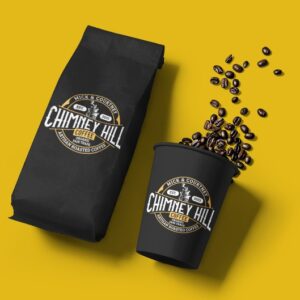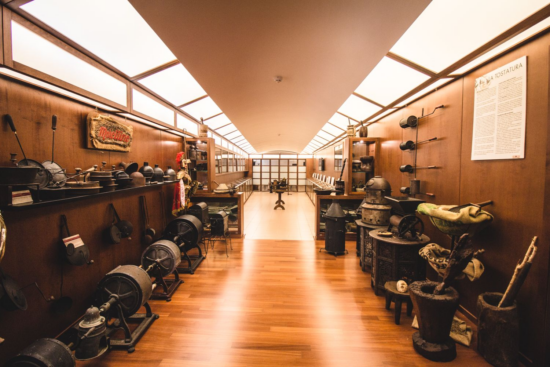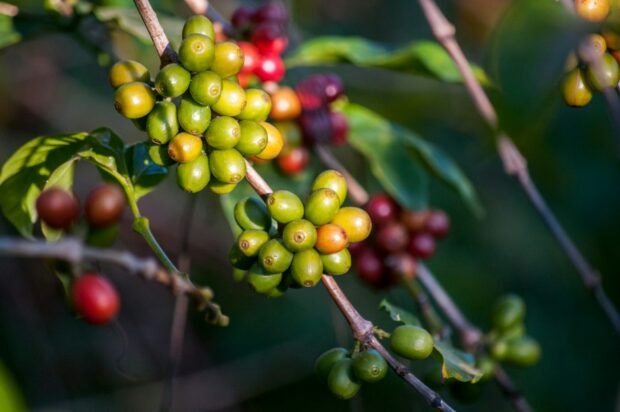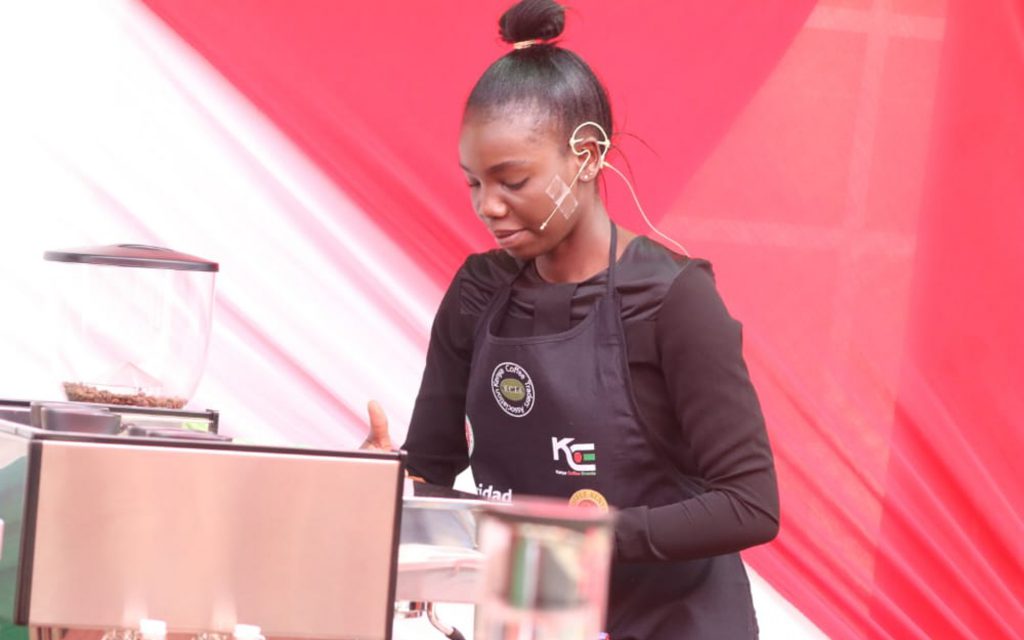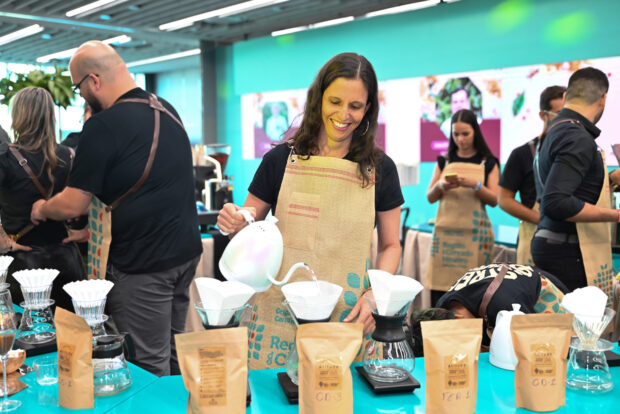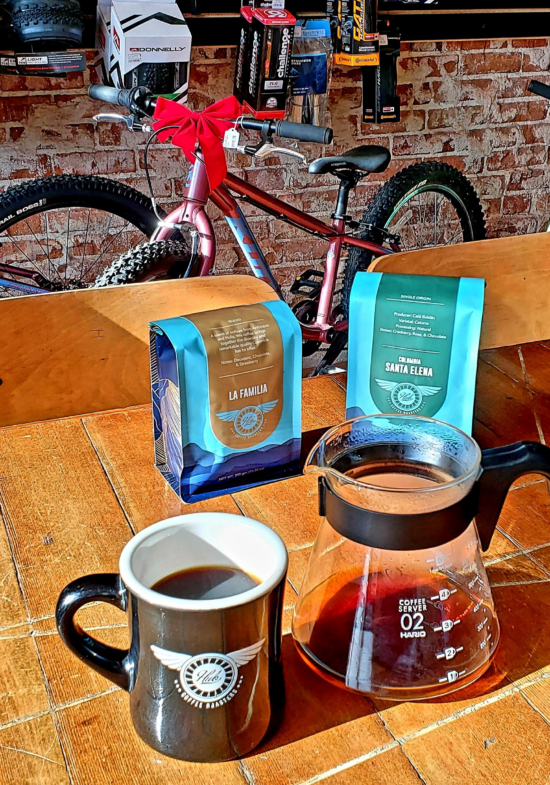Not sure how to change Keurig 2.0 water filter? Here are step-by-step instructions that will help you do it quickly and easily. Keurig water filter should be changed every 2 months or 60 tank refills. The water filter is located inside the water tank, on the valve at...
2023 Preview: Coffee Trends, Controversies and Change
2023 Preview: Coffee Trends, Controversies and Change
2023 Preview: Coffee Trends, Controversies and Change
2023 Preview: Coffee Trends, Controversies and Change
2023 Preview: Coffee Trends, Controversies and Change
2023 Preview: Coffee Trends, Controversies and Change
I Tested Keurig K Compact – Here’s Everything You Need To Know
The most affordable Keurig coffee maker is available exclusively at Walmart and comes at a sweet price of only $59.00. In this article, you’ll find out how good it really is, and also find additional information like how to clean it, or do you need a water...
Quick French Press Iced Coffee (No, It’s Not Cold Brew)
This is the absolute fastest way to make French press iced coffee. Just forget about cold brew concentrate – with this Quick French Press Iced Coffee Recipe you can have your iced coffee ready in 5 – 6 minutes. Who doesn’t like the French press?! It’s...
The coffee rose for assessing Anaerobic coffee
I just came across this really neat tool to assess anaerobic coffees. I haven't used it for cupping yet. I'm not sure I will like it either because the idea of lowering the score of the coffee just because it tastes has some thyme flavors. At the same time I...
Three US Coffee Championship Events Are Heading To Rancho Cucamonga
This article is from the coffee website Sprudge at http://sprudge.com. This is the RSS feed version. The 2024 US Barista Championship, Brewers Cup, and Cup Tasters will take place March 15-17 at Klatch Coffee Roasters in Rancho Cucamonga, California.
The Origin Story of Turtle Island Coffee in Vancouver, B.C.
A new Indigenous-owned coffee company based in Vancouver, British Columbia, called Turtle Island Coffee has launched with the goal of exposing more people to high quality specialty coffee and Indigenous...
Get Ready for The Barista League’s 2024 Season
The Barista League has announced 12 competitions across four continents. BY J. MARIE CARLANBARISTA MAGAZINE ONLINE Photos courtesy of The Barista League When The Barista…
Get Ready for The Barista League’s 2024 Season
The Barista League has announced 12 competitions across four continents. BY J. MARIE CARLANBARISTA MAGAZINE ONLINE Photos courtesy of The Barista League When The Barista…
Get Ready for The Barista League’s 2024 Season
The Barista League has announced 12 competitions across four continents. BY J. MARIE CARLANBARISTA MAGAZINE ONLINE Photos courtesy of The Barista League When The Barista League announces new events, it’s worth paying attention! This year, the schedule will be...
Weekly Coffee News: EUDR and Africa + More Celebrity Coffee
Welcome to DCN’s Weekly Coffee News. Keep up with all the latest coffee industry stories and career opportunities by subscribing to DCN’s newsletter. Tell our editors about your news here. Report: Small-Scale Farmers in...
Do Higher Coffee Prices Mean More Money For Farmers? A Story From Sumatra Shows It’s Complicated
This article is from the coffee website Sprudge at http://sprudge.com. This is the RSS feed version. Since coffee costs more now than ever, do those coffee prices impact the amount of money earned by coffee farmers?
Coffee News Recap, 2 Feb: Applications open for Australia’s Richest Barista 2024, De’Longhi reports 4.6% revenue increase after La Marzocco move & other stories
Every Friday, Perfect Daily Grind rounds up the top coffee industry news from the previous week. Here are this week’s coffee news stories. The word of the week is: expansion. Mon, 29 Jan AeroPress launches limited-edition Clear Pink brewer. The coffee brewer is made...
Watch The 8 Best Coffee Videos Vying For Sprudgie Awards
This article is from the coffee website Sprudge at http://sprudge.com. This is the RSS feed version. The best coffee videos from 2023 featuring Cafe Imports, Aramse, Nguyen Coffee Supply, Wildly, Mirror Coffee Roasters, Alto Stories, Quek Shio, and Cafe Retiro.
Robusta is great and has untapped potential
I live in the US and my typical choice of coffee is lightly roasted Ethiopian pour overs. I generally love acidity and fruit flavors in my coffee. My experience with Robusta has often been poor. Very dark, roasty and maybe chocolatey. I participated in the Hoffman...
Design Details: Brewing Reinvented at ULA Café in Melbourne
Welcome to Design Details, an ongoing editorial feature in Daily Coffee News focused on individual examples of coffee shop architecture, interior design, packaging design or branding. If you are a coffee...
Robert Downey Jr.’s New “Happy Coffee” Is Really Depressing
This article is from the coffee website Sprudge at http://sprudge.com. This is the RSS feed version. Robert Downey Jr. and Craig Dubitsky team up for Happy Coffee.
Out Now: The February + March 2024 Issue of Barista Magazine!
In our new issue we feature Lisa Lawson from Glasgow, Scotland, take a look at the newest grinders, explore spring drink inspiration, see how more women are getting involved in coffee tech, and much more! BY SARAH ALLENBARISTA MAGAZINE We’re stoked to announce the...
The coffee industry’s biggest competition: The story of the World Barista Championship
Every year, the global coffee industry gears up for one of its most exciting and groundbreaking competitions: the World Barista Championship. For more than two decades, the WBC has been one of the biggest catalysts for change and innovation in specialty coffee, and...
The 2023 Specialty Coffee Transaction Guide Has Landed
The 2023 edition of the Specialty Coffee Transaction Guide (SCTG) guide went live today, providing actors throughout the coffee chain a data-driven tool for green coffee price discovery. The full...
Espro great until I needed replacement filter ☹️
I've had an Espro P7 for nearly four years after seeing glowing praise on this sub (to which I later contributed). Before I bought the P7 I looked at the replacement parts available and they seemed like a solid company in that they sold e.g. replacement filters...
New Bill Requires More Kona In Your Kona Coffee
This article is from the coffee website Sprudge at http://sprudge.com. This is the RSS feed version. Currently a coffee only need to be 10% Kona to be labeled as such.
What’s the best and worst part about owning and running a coffee shop?
I'm not interested in getting into it myself, as I have no experience in the service industry, no real appetite for risk and no desire to run a business in general. But sometimes I think about it and I wonder what's the most enjoyable thing about it and...
minimum dose size?
I use the Hario switch to brew my coffee and am trying to reduce my caffeine consumption. Hence I would like to brew smaller cups of coffee. I am currently using 10g of coffee with 160g of water. (1:16 Ratio) I am wondering if there is a minimum amount of coffee...
[CAFE OWNERS] Background before starting a shop?
I’ve worked in coffee for 6 yrs as a barista and shift supervisor and have passion for it. I’ve decided that I want to open my own place in the future and so I’ve been doing the research to make a business plan. Lately, however, I’ve begun to realize just how many...
2023 Preview: Coffee Trends, Controversies and Change


What is trending in the specialty coffee world for 2023? What will be 2023’s major controversies or issues? Which origin countries or regions should Coffee Review look in on? Every December brings a round of often intense debate and speculation as we at Coffee Review exchange emails and bang heads trying to come up with topics for the following year’s 10 tasting reports.
For these reports, we test anywhere from 30 to 100 coffees that relate to the report topic. Based on our tasting, descriptions and ratings, we choose 10 or more coffees that we review in detail, and that provide the descriptive backbone for each report.
Here are our report topics for 2023, many chosen with particular focus on what we see as specialty coffee trends in the coming year.
February 2023: Coffees from Roasters in Ski Country
We start the year with a seasonal report by having a look at what local roasters are up to in ski country. Beyond the “coffee” served at mostly corporate eateries at ski lodges, whose chief characteristics are “hot” and “brown,” what else is going on in the base-camp towns where residents also get their morning fix? We review a range of coffees from specialty roasters in proximity to North American slopes.
March 2023: The Anaerobic Processing Trend
Lately, coffee producers and their export partners have been busy aiming to excite the coffee world with new taste profiles created by experimenting with processing methods, i.e., how the fruit is removed from the beans and how they are dried. The almost universal processing method for fine coffee up to around 2010 or so was the wet or washed method, in which the soft fruit residue is entirely removed from the beans after harvest and before they are dried. The supremacy of the washed method in fine coffee was first challenged by a return to the ancient dry or natural method, in which the beans are dried in the entire fruit, giving us the now-familiar “naturals” with their potential for sweetness and fruit character. Around the same time, a fashion for “honey” processing took off — here, the skins of the coffee fruit are removed immediately after picking, but the beans are dried with at least some of the sweet, sticky fruit flesh still adhering to them.
And now, we are being inundated with “anaerobic-” processed coffees, meaning that, at some point in their journey from tree to drying table, the beans are sealed inside tanks to ferment with no (or very little) exposure to oxygen, discouraging oxygen-loving, sweet-alcohol-promoting yeasts while encouraging oxygen-averse bacteria. The bacteria-rich ferment often promotes a tangy sweetness with a slight lactic edge, as well as frequently surprising aromatic notes that can range from musk to bubble gum. There are many variations on the anaerobic method with varying sensory outcomes. For example, the fermentation may take place after removal of the skin (anaerobic honey or washed) or before the removal of the skin and drying (anaerobic natural).
We will revisit the anaerobic phenomenon in our March 2023 report. Will our testing of a broad range of anaerobics suggest that the latest flood of such experiments is expressing the method with more finesse, perhaps taming it, smoothing it out? Or do the exciting, often peculiar, occasionally disturbing sensory surprises of the method still dominate, delighting coffee adventurers while provoking traditionalists?
April 2023: Testing Those Ubiquitous Coffee Bags
Ground coffee in steepable filter bags (they look roughly like tea bags, but are larger) sold in single-serve nitrogen-flushed, atmosphere-protective packaging seem to be popping up on virtually every roasting company website we visit of late. The pitch, of course, is convenience: no grinding, no measuring, just pull the bag out of its little envelope and immerse it the right temperature water for the right length of time. In most cases, the coffee inside the bags is specialty quality, and the bags and packaging make a mighty effort to reduce waste and potential negative impact on the environment.


This coming April we test and review coffees sold pre-ground in single-serve steepable bags.
But how good is the beverage produced by these convenient little expedients? What impact does grinding and packaging, months in advance of brewing, have on exceptional coffees? And which of the many roaster and coffee names on the bags are likely to produce an exciting cup?
We look forward to finding out and sharing our findings with our readers in our April 2023 report and reviews.
May 2023: A Reviving Origin — Java and Bali
One massive trend throughout the specialty coffee world is the breakdown of a predictable relationship between country of origin and cup profile. Widespread experimentation with processing methods and introduction of new tree varieties are complicating the once familiar relationships between cup character and origin. Looking back over our recent reports on coffees by origin country, often half or more of the samples we receive represent coffee types not typical of the origin we are surveying. With our recent cupping of Mexico coffees, for example, only 40% of the coffees sent to us by roasters were processed by the traditional washed method, which, for decades, constituted an absolutely essential indicator of a high-quality Mexico coffee.
The growing discrepancy between country of origin and predictable cup character explains why we are planning more frequent reports on processing method and variety in 2023 than reports on specific coffee origins. We are, however, planning a report on the interesting developments on the Indonesian island of Java, where the longstanding traditional profile of Java coffee, based on standard washed coffees produced by a handful of government-owned estates, is now being supplemented by a lively community of smallholding producers who are turning out an array of interesting coffees ranging from traditional Indonesian wet-hulled coffees to natural, anaerobic and traditional washed types. This complexity is being supplemented by a similarly varied production from the neighboring island of Bali. Look for our May 2023 report on the coffees of Java and Bali.
June 2023: Lighter Roasts and Dark-Roast Confusion
What is a “dark-roasted” coffee in 2023? With many of the smaller upmarket roasters who submit coffees to Coffee Review, “dark roasts” may not be dark at all. They are most often what we could call “medium-dark” or even “medium” roasts, in which even a trained palate will have difficulty picking up a hint of the rich, scorchy taste beloved by those who like “real” dark roasts. Yet, if we look in the opposite direction, toward companies that built their original brands on clearly defined dark roasts, like Starbucks and Peet’s, we face the opposite ambiguity. A Starbucks “blonde” roast, for example, the lightest roast Starbucks generally distributes, is almost the same darkness of roast as are most third-wave roasters’ “dark” roasts. We know because we measure darkness of roast by instrument, in our case an Agtron near-infrared spectrophotometer that reliably identifies degree or darkness of roast.
Where does that leave consumers? Confused, most likely, particularly if they try to choose roast color by the language on coffee bags and websites.


What makes a roast “dark”? Contemporary coffee roasters differ on their definitions. Courtesy of Kenneth Davids.
In our June 2023 report, we’ll do our best to sort through the language and the reality of today’s dark-roast labels in North American specialty coffee, along with, of course, reviews of the best examples of both kinds of “dark” roasts, old and new.
July 2023: Reviewing Alternative Milks for Espresso
Part of a much larger movement away from animal-based foods, most contemporary cafés now offer customers at least one, often several, plant-based substitutes for dairy milk in drinks like cappuccino and caffè latte, including soy milk, almond milk, oat milk and others.
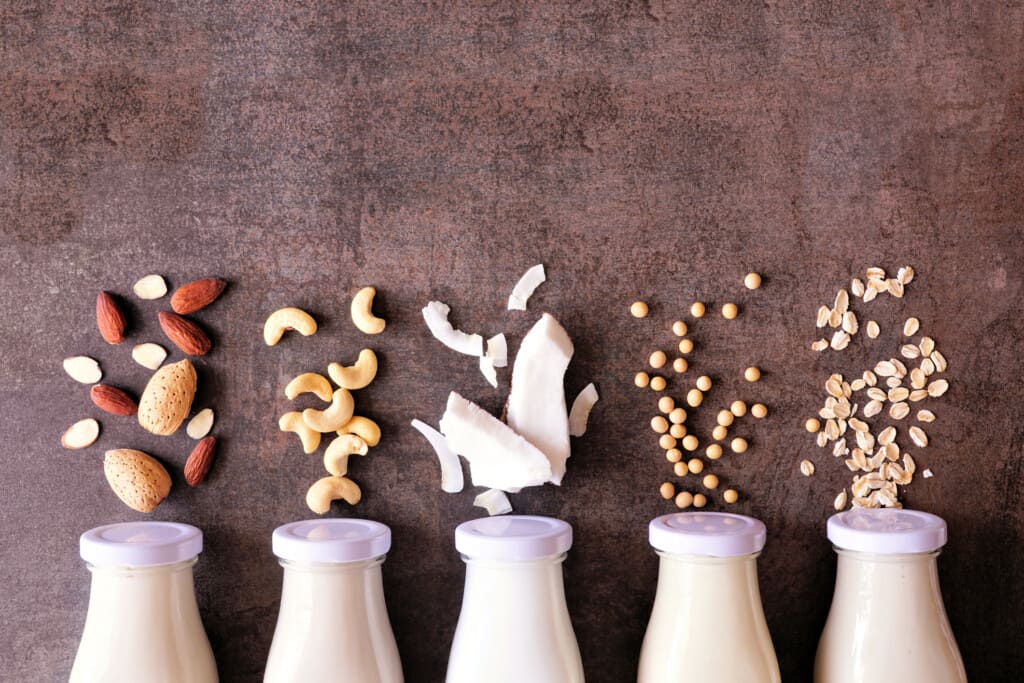

A spectrum of plant-based milks. For our July 2023 report we test and review a range of such alternative milks as they perform when frothed and combined with espresso.
For our July 2023 report, we’ll test several plant-based milks widely used in the coffee world. The focus will not be on the coffee but rather on the performance of the milk substitutes: in sensory partnership with the coffee, in ease of use, and in the texture and resilience of the froth. We will choose coffees of two different roast levels to test with the alternative milks.
August 2023: Women Producers in Charge
In our June 2017 report, we first considered women coffee producers in a global context. We turned up a heartening number of roasters focused on highlighting women-farmed coffees, as well as several non-profits dedicated to empowering women farmers. In our August 2023 report, we’ll look at the current players in the important work of supporting and making more visible the agricultural contributions of women to the coffee industry and review the finest women-farmed coffees we turn up from their roaster partners.
September 2023: Making Sense of All Those Ethiopias
Is Ethiopia itself something of a trend? Possibly, judging by the sheer number of reviews of Ethiopias crowding our review pages, outnumbering reviews of coffees from most other origins. The reasons for this are many, but most are tributes to Ethiopia’s unique place in in the world of coffee. Coffea arabica originated in Ethiopia, and coffees grown there today are virtually entirely produced from selections of indigenous coffee, almost all with genetic-driven potential for vivid aroma/flavor notes and balanced, sweet-leaning structure.


Ethiopian couple enjoying coffee in a village coffee ceremony in 1999 in the Yirgacheffe region. Courtesy of Kenneth Davids.
We have the idea, however, that the sheer volume of reviews of Ethiopia coffees may discourage some readers from fully exploring their unique pleasures. So, with our September 2023 report, we’ll look back at Ethiopia coffees reviewed in previous months, perhaps supplemented by additional samples freshly sourced, and offer an outline of Ethiopia coffee styles and cups, together with ways readers might look beyond rating numbers to the details of our reviews when choosing Ethiopia coffees to enjoy.
October 2023: Hoping for Another Geisha — Rare Regional Varieties Go Global
The Geisha/Gesha variety of Arabica, originating in Ethiopia but rediscovered and first publicized in Panama in 2004, has changed the face of specialty coffee. Geisha’s startlingly distinctive character confirmed that variety counts in the cup, and that the botanical variety of Arabica tree is one of the leading factors that impacts a coffee’s cup quality and character. Since then, Geisha has been carried to many parts of the coffee-growing world, including a revival in its original home in Ethiopia, and, as it gradually becomes less precious and less costly, is on its way to becoming a commonplace high-end coffee pleasure.
Another impact of Geisha has been to set the coffee world searching for additional distinctive, potentially superstar varieties. Wush Wush (Ethiopia), Sidra (Ecuador), Pink Bourbon (Colombia) and Sudan Rume are among varieties that display a distinctive cup profile, and are being promoted as something different and exciting, deserving to be planted in fields far from their original homes. The increasing affordability of genetic fingerprinting has intensified and supported this quest. A group of researchers has discovered varieties of Arabica in Yemen that appear to be unique to that country. Varieties like Ecuador’s Sidra, once considered a local spontaneous hybrid of Bourbon and Typica, may, based on genetic fingerprinting, turn out to be an Ethiopia variety naturalized far from its original home.
Look for our October 2023 report, which will focus on coffees produced by these new variety-star hopefuls.
November 2023: The Fermenting-with-Fruit Trend
On the heels of the challenge to tradition represented by anaerobic processing (see the preview of our March 2023 report above), still another processing wrinkle is arriving to challenge coffee purists. A few innovating coffee producers have begun to add natural fruit or spices to the fermentation tank along with the coffee fruit or beans. This procedure does not produce the sensory equivalent of the artificially flavored beans that coffee enthusiasts have long condemned, with their overstated, metallic, cloying flavors. So far, our limited tasting of natural fruit-fermented coffees has found that their added aroma/flavor notes are generally well-integrated into the basic coffee profile rather than an intrusive, distracting overlay.
Still, the procedure is understandably offensive to coffee traditionalists. In particular, some coffee leaders who support Cup of Excellence and similar green coffee competitions argue that these fruit-added fermentation experiments are essentially cheating on the fundamental act of coffee production. A few critics have attacked the anaerobic processing practices sketched earlier in this report on similar grounds.
For our November 2023 report, we will taste as many of these fermented-with-natural-fruit (or spice) experiments as we can turn up. After sampling a range of them, we will review those we consider most successful and report on the status of the controversy around them.
An Eventful Year Ahead for Coffee
Innovation and change in the specialty coffee world show no sign of slowing down, while traditionalists push back with ever more refined resistance. We’re looking forward to a provocative and engaging year of tasting. We hope you’ll come along.
The post 2023 Preview: Coffee Trends, Controversies and Change appeared first on Coffee Review.

